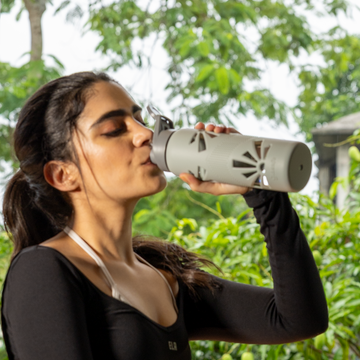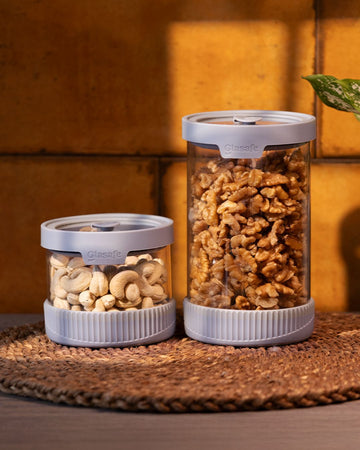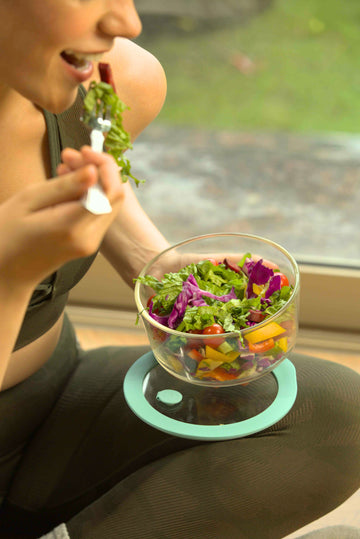What’s the most visited room in your home? Not the living room, not the bedroom—it’s the kitchen. It’s the heart of every home and the keeper of everyone’s favorite thing: food. From the aroma of a home-cooked curry to the satisfying crunch of a perfectly fried chip, food brings comfort, joy, and a sense of connection. But here’s the secret ingredient to preserving that magic: a smart storage solution. Let’s explore the art of storing food right and the modern essentials that make freshness a lifestyle, not a fluke.
The Importance of Using Borosilicate Glass Containers for Food Storage
Let's first discuss the significance of storing food in borosilicate glass containers before moving on to the food storage advice.
-
Safety: Your food will stay pure and safe to eat because borosilicate glass is non-toxic and doesn't release any dangerous chemicals.
-
Temperature Resilience: You may transfer hot or newly cooked food straight because it can tolerate drastic temperature changes without breaking.
-
Transparency: By allowing you to see the contents without opening the container, clear borosilicate glass reduces exposure to light and air.
-
Airtight Seal: To increase shelf life, many containers feature airtight lids that protect against moisture, air, and undesirable odors.
-
Versatility: This all-in-one solution is safe to use in the oven, microwave, dishwasher, refrigerator, and freezer.
-
Preserves freshness: Airtight seals help preserve freshness, which is important for perishable goods like cooked meals, fruits, and vegetables.
-
No flavor retention: Borosilicate glass doesn't retain flavors or odors; therefore, the flavor of your present meal won't be impacted.
-
Sustainable: Reusable and robust, they lessen the need for throwaway containers, which promotes environmental sustainability.
-
Aesthetic: Stunning glass containers make your food look better and are ideal for feeding guests or special occasions.
10 Guidelines for Safe Food Storage
It's important to store the food. The following are the greatest methods for keeping food fresh while storing it:
1. Keep pulses and grains in sealed containers.
Use 100% borosilicate jars instead of plastic ones. They have airtight closures that keep moisture out of your food. Unlike plastic containers, borosilicate glass jars don't release toxins, so your food is safe to eat. To use larger jars for grains you use more frequently, choose jars that come in a variety of sizes!
You may be wondering why switching to borosilicate jars for your pulses is a good idea. The freshness of these jars is protected by their airtight lids. They provide a protective atmosphere that keeps your grains and pulses safe from any deterioration by keeping out air and moisture. Because borosilicate glass jars don't leach toxins into your food as their plastic counterparts do, your food will stay pure and unadulterated.
2. Label your containers
Although the glass jars or containers mentioned above are transparent, not every member of your family can distinguish between the various types of days. Even a novice cook will feel more at ease in the kitchen if they are labeled. It's similar to assigning a small signpost to each ingredient. It's a straightforward action with amazing results. It not only saves time, but it also avoids uncertainty or poor decisions at the last minute when cooking. They can be labeled with permanent markers. Another way to add excitement is to pair each color with a different kind of cuisine.
3. Create space by stacking
Organizing your space is crucial if your kitchen is small or your cabinets are small. Stackable jars and containers are ideal for creating and using your storage space, but if your cabinets are already roomy, a divider can help you make better use of the available space by showcasing your ingredients more clearly and keeping jars from toppling over or falling.
4. Select odor-free jars
These are ideal for preserving the freshness of your food. Your container will smell and look brand new after just one quick wash, and it will be ready to hold additional food. The magic is here: The borosilicate used to make these jars doesn't retain odors. Therefore, you won't experience a strange mixture of smells if you had strawberries in there today and garlic yesterday. They do a fantastic job of maintaining the distinct and unadulterated flavors of your cuisine. You don't have to worry about residual smells when you move from keeping spaghetti to cookies.
5. Keep the ingredients you use the most close at hand
The items you use most frequently should be kept closest to your cooktop. Therefore, that particular component is nearly as close as all the other ingredients that are already assembled on your stovetop, even if you forget to keep it ready during meal prep.
6. Keep pre-mixes in airtight jars
Consider that you have a full day ahead of you and are intending to prepare dinner. Making everything you'll need to cook in the morning and storing it is one practical method. The most effective way to save time is to prepare pre-mixes. You must store your pre-mix in sealed containers to prevent spoiling.
They also eliminate any humidity and keep your blend fresh. They keep out moisture and other contaminants that could contaminate your food while retaining all the deliciousness inside. No matter the season, you can make sure your pre-mixes remain fresh and undamaged by using sealed jars.
7. Keep leftovers in glass containers that won't leak.
The most often stored items are leftover foods. Please don't put any curry in your refrigerator. It's as challenging to clean as it was to consume. Airtight, leak-proof glass containers are crucial for protecting your food from toxins, stopping leaks, and getting rid of any lingering odor.
Glasafe food containers are also transparent. If you can't remember where you put your spaghetti, you can simply skip opening each box. The fact that these containers can tolerate temperatures of up to 350 degrees Celsius is yet another fantastic benefit. They fit well in the refrigerator when they require a cozy place, and you can use them to reheat your delicious leftovers immediately in the microwave.
8. Use glass storage containers to make your four-step method one-step
Glass storage containers make it easy to combine your four-step process of heating, serving, cleaning, and storing into a single, easy step. They are ideal for storing food, as was previously said. Since they are microwave-proof, you may reheat your food without contaminating another container. Glass containers make the ideal serveware because they are elegant and streamlined. They leave no lingering smell and are simple to wipe up. And voila! The best part is that you can pack snacks or lunches to go with these containers.
9. Storage of snacks and munchies
The majority of us enjoy munching and snacking! One of the best snacks to eat is popcorn, for instance. However, it is healthier to avoid popping all the kernels at once. Popcorn kernels are susceptible to insect infestation, so it's crucial to keep them in sealed jars or containers and store them securely in the refrigerator or freezer. The worst is when snacks "sil jaate hai," which is why it's so easy to keep them crunchy in airtight, freezer-safe jars!
10. Use glass bottles to store drinks
Have you ever kept shakes or juices in a plastic container and, despite three washings, been unable to eliminate the odor? This issue doesn't even arise with borosilicate glass bottles that don't smell! Keep buttermilk, juices, smoothies, and other items fresh in the refrigerator without worrying about lingering odors.
FAQs
What are the 5 guidelines for food storage?
-
Keep It Clean: Keep food in areas that are dry, clean, and pest-free.
-
Keep cooked and raw food separate to avoid cross-contamination.
-
Keep at safe temperatures, either above 60°C (hot) or below 5°C (cold).
-
Label and rotate using the First In, First Out (FIFO) method.
-
Check expiration dates; do not keep damaged or expired items in storage.
What is the best way to store food?
Airtight containers kept in the proper environment (pantry, freezer, or refrigerator), paying attention to moisture content, temperature, and exposure to light or air.
What is the golden rule of food storage?
Keep hot foods hot and cold foods cold – avoid the temperature "danger zone" (5°C–60°C).
What are the 5 traditional ways of storing food?
-
Drying
-
Salting
-
Fermenting
-
Pickling
-
Smoking
What is proper storage?
It means maintaining food under hygienic, safe, and appropriate settings to maintain nutrition and freshness while avoiding infection or spoiling.
What is the 2-hour rule for food safety?
To stop bacteria from growing, perishable food shouldn't be kept out at room temperature for longer than two hours (or one hour if it's above 32°C).
What are high-risk foods?
Foods that spoil easily and support rapid bacterial growth, including:
-
Cooked rice and pasta
-
Meat and poultry
-
Seafood
-
Dairy products
-
Eggs
-
Prepared salads
Which is better for food storage?
Generally speaking, depending on the food:
-
Glass containers for non-reactivity, safety, and long-term storage
-
Plastic for temporary and portable applications
-
Using a vacuum seal to prolong freshness
What's the correct method of food storage?
-
Raw meat should be kept apart.
-
Date and label every food item.
-
Dry goods should be stored in sealed containers.
-
Make proper use of freezing (≤-18°C) and refrigeration (≤5°C).
-
Observe First In, First Out (FIFO).
What is the danger zone of food?
5°C to 60°C (41°F to 140°F) – temperatures where bacteria grow rapidly.
What are the top 10 ways to keep food safe?
-
Clean your hands and surfaces.
-
Keep it at the proper temperature.
-
Steer clear of cross-contamination
-
Make sure to fully cook the meal.
-
Keep food covered.
-
Make use of sanitized containers.
-
Keep an eye on expiration dates.
-
Avoid reheating thawed meals.
-
Quickly chill hot food.
-
Make use of sanitized cutlery.
How to store food correctly?
-
Make use of airtight containers.
-
Put the name and date on the label.
-
Keep cooked and raw foods apart.
-
Keep your refrigerator in good working order.
-
Dry products should be kept in cold, dark areas.
What are 10 chemical food preservatives?
-
Sodium benzoate
-
Sodium nitrite
-
Sorbic acid
-
Propionic acid
-
Sulfur dioxide
-
Calcium propionate
-
BHA (Butylated Hydroxyanisole)
-
BHT (Butylated Hydroxytoluene)
-
Citric acid
-
Ascorbic acid
What causes food to go bad?
-
Microbial development (molds, bacteria)
-
Activity of enzymes
-
Loss or gain of moisture
-
Oxidation
-
Inappropriate temperature
-
Exposure to light
-
Cross-contamination





